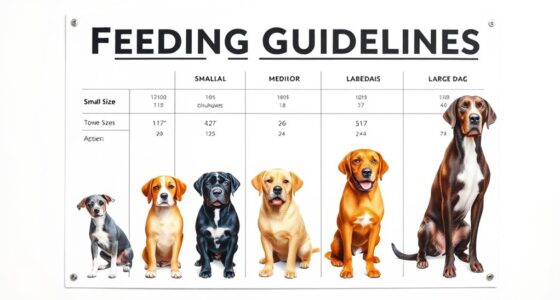To decode canine body language, pay attention to their tail, ear, eye, and overall posture. A relaxed, wagging tail and soft eyes show happiness, while tense muscles, tucked tail, or wide eyes indicate fear or stress. Watch for signs of aggression like stiff stance or growling. Subtle cues such as lip licking, ear position, and body tension reveal their emotional state. Keep observing these signals, and discovering their meanings becomes clearer as you continue to explore more examples.
Key Takeaways
- Observe tail position and movement to gauge excitement, relaxation, or stress levels in dogs.
- Recognize facial cues like lip licking, ear orientation, and eye dilation to interpret emotional states.
- Identify signs of fear or aggression such as stiff posture, growling, or tense muscles to ensure safety.
- Note body language signals like leaning, shifting weight, or stiff stance indicating uncertainty or stress.
- Understand breed-specific behaviors and environmental influences for accurate decoding of canine emotions.
Recognizing Relaxed and Happy Postures

When a dog is truly relaxed and happy, it shows through its body language in clear, recognizable ways. You’ll notice a loose, wagging tail, soft eyes, and a relaxed mouth, often with a slight open-mouthed smile. Ears are typically in a neutral position, and the body appears loose rather than stiff. Keep in mind that some canine communication myths suggest that a wagging tail always indicates happiness, but context matters. Recognizing these cues can help you better understand your dog’s mood, especially during grooming sessions. Incorporating simple dog grooming tips, like gentle handling and calm environments, encourages relaxation. Paying attention to these relaxed postures helps you read your dog’s signals more accurately and supports positive interactions.
Identifying Signs of Fear and Anxiety

Even when a dog appears relaxed and happy, certain subtle cues can reveal underlying fear or anxiety. These signs often stem from early puppy socialization and learning canine communication cues. Watch for body language like tense muscles, lip licking, or avoiding eye contact. A fearful dog may also cower, tuck their tail tightly, or show wide eyes. Recognizing these signals helps prevent escalation and supports positive interactions. Use this table to identify common signs:
| Sign of Fear/Anxiety | Description |
|---|---|
| Lip licking | Sign of discomfort or stress |
| Tucked tail | Feeling threatened or insecure |
| Avoiding eye contact | Submissive or fearful posture |
| Shaking or trembling | Physical response to fear |
Understanding these cues enhances your puppy socialization efforts and improves canine communication. Additionally, being aware of water-based cues can help in understanding and calming anxious dogs. Recognizing how dogs respond to environmental stimuli can also provide insights into their emotional state. Being attentive to body language signals is crucial for developing a trusting relationship with your dog, especially when they are experiencing anxiety triggers.
Interpreting Aggressive and Defensive Signals

Recognizing aggressive and defensive signals is essential for ensuring safety and understanding a dog’s true intentions. Breed-specific signals influence how a dog displays these behaviors; for example, herding breeds may use intense eye contact, while terriers might growl more openly. Environmental influences also shape these signals—crowded spaces or unfamiliar surroundings can heighten a dog’s defensiveness, leading to raised hackles or a stiff stance. Look for warning signs like lip licking, yawning, or a tense body, which can indicate the dog feels threatened. If a dog shows teeth, stiffens, or bears its teeth, it’s a clear sign of aggression or defensiveness. By understanding these cues, you can better interpret a dog’s emotional state and respond appropriately to prevent escalation.
Understanding Playful and Excited Gestures

Understanding playful and excited gestures is key to safely engaging with a dog and interpreting their mood accurately. When a dog displays playful gestures, you might notice a relaxed body, wagging tail, and open mouth that resembles a smile. Excited behaviors often include jumping, spinning, or bouncing around energetically. These signals show your dog is happy and enthusiastic to interact. Look for a loose, wagging tail, perked ears, and an overall lively attitude — signs they’re in a joyful, playful state. Recognizing these cues helps you respond appropriately, ensuring your interactions are positive. Remember, a dog’s excitement can escalate quickly, so stay attentive to their body language. Being aware of canine body language can greatly improve your understanding and safety during play. Understanding playful gestures can also help prevent overexcitement or accidental nips. By understanding these playful gestures, you create a safe environment for both you and your canine companion to enjoy playtime.
Decoding Subtle Facial Expressions

You can learn a lot about a dog’s mood by paying attention to subtle facial cues like lip licking and ear positions. These small signals often reveal their comfort level or alertness before more obvious behaviors appear. Recognizing these cues helps you respond appropriately and build a stronger bond. Staying aware of AI security vulnerabilities in technology can also teach us the importance of paying attention to subtle signs of risk and ensuring safety measures are in place. Being attentive to canine body language enhances your ability to interpret their feelings accurately and respond with empathy. Additionally, understanding the advancements in machine learning behind AI systems can improve our ability to detect and mitigate potential security threats effectively.
Lip Licking Cues
Lip licking is a subtle but important signal that can reveal a dog’s emotional state. You might notice your dog licking their lips after grooming behaviors or when they’re feeling anxious. This gesture often indicates discomfort, submission, or uncertainty. Dogs also lick their lips as part of scent marking, especially in social situations, to subtly communicate their presence or establish boundaries. When your dog repeatedly lip licks during interactions, it could suggest stress or a desire to diffuse tension. Pay attention to the context—if they lick their lips alongside other signals like avoiding eye contact or downward posture, it’s likely a sign of unease. Recognizing these cues helps you better understand your dog’s feelings and respond appropriately to keep them comfortable. Decoding facial expressions can also provide additional insight into their emotional state. Additionally, understanding dog names and their associations can sometimes influence how your dog perceives interactions, making it easier to interpret their signals accurately. Awareness of mental wellbeing indicators can help you notice subtle shifts in behavior that reflect your dog’s emotional health.
Ear Position Signals
Ear positions are subtle yet powerful indicators of a dog’s emotional state and intentions. By observing ear positioning, you can gauge how your dog feels in any situation. When a dog’s ears are forward and alert, it often signals curiosity or focus. Conversely, ears that are pinned back or flattened indicate fear, stress, or submission. Ear rotation is also significant; a dog that tilts or swivels its ears might be trying to better hear or assess its environment. Pay attention to these cues, as they reveal body language that might not be immediately obvious. Recognizing these signals helps you respond appropriately, whether it’s offering reassurance or giving space. Understanding ear positioning and rotation is essential for decoding your dog’s emotional message. Additionally, being aware of dog quotes for reflection and humor can deepen your connection and understanding of your pet’s inner world. Being attentive to these subtle cues can also help in identifying potential behavioral issues before they escalate, allowing for timely intervention. Moreover, awareness of canine body language can improve safety and strengthen your bond with your dog.
Reading Tail Movements and Positions

Your dog’s tail position reveals a lot about how they’re feeling, from relaxed to anxious. Wagging speed can indicate excitement or agitation, so pay attention to how quickly they move their tail. The curve of their tail also matters—a gentle curl can mean friendliness, while a stiff or raised tail signals alertness or dominance.
Tail Position Indicators
The position and movement of a dog’s tail can reveal a lot about its emotional state. You can learn a lot by observing whether the tail is high, low, or drooping. For example, tail flicks often indicate excitement or agitation, while a tail droops suggest submission or sadness. When the tail is held high and stiff, your dog might feel confident or alert. Conversely, a relaxed, low tail or one that droops signals comfort or submissiveness. Recognizing these signs helps you better understand your dog’s feelings and reactions. Monitoring body language cues like tail position is essential for assessing your dog’s mood accurately, especially since tail movements can be influenced by various emotional and physical factors. Paying attention to tail support and positioning can also provide insights into your dog’s overall wellbeing and comfort level. Additionally, consistent observation of tail behavior over time can help identify changes that may indicate health issues or stress.
Wagging Speed Clues
Wagging speed can reveal a lot about a dog’s emotional state, often more than the wag itself. In dog body language, the pace of a wag signals how excited or calm a dog feels. A rapid wag usually indicates high excitement, happiness, or enthusiastic eagerness, while a slow wag suggests relaxation or mild interest. When you observe a dog’s tail moving quickly, it’s a sign of playful or alert canine communication. Conversely, a slow wag may mean the dog is comfortable or unsure. Pay attention to these subtle cues to better understand what your dog is feeling. Recognizing wagging speed helps you interpret canine communication more accurately, improving your understanding of dog behavior, and ensuring safe, respectful interactions. Being aware of these cues can also help prevent misunderstandings that could lead to dog bites or defensive behavior.
Tail Curvature Meaning
By paying attention to the curvature of a dog’s tail, you can gain valuable insights into its emotional state. The tail’s position reveals important clues in dog communication and helps you understand canine emotions. A raised, curved tail often indicates excitement or confidence. A straight, stiff tail may show alertness or suspicion. A tucked tail signals fear or submission, while a low, relaxed tail suggests contentment or calmness. Recognizing these nuances allows you to interpret your dog’s feelings accurately. Remember, tail curvature isn’t isolated—it works alongside other body language cues for a complete picture. Understanding dog body language enhances your ability to respond appropriately to your pet’s needs. Being aware of these signals can also help prevent misunderstandings and promote better bonding with your dog.
Analyzing Ear and Eye Cues

Understanding a dog’s ear and eye cues offers valuable insight into their emotional state. Ear flicks can indicate curiosity, agitation, or relaxation, depending on their timing and direction. For example, quick ear flicks might signal alertness or uncertainty, while relaxed ears suggest comfort. Eye dilation also reveals a lot; dilated pupils often show excitement, fear, or stress, while constricted pupils typically mean calmness or contentment. Pay attention to the overall context—combined with other signals—to interpret your dog’s feelings accurately. Notice if their ears are perked up or laid back, and observe how wide their eyes are open. These subtle cues help you understand whether your dog is feeling playful, anxious, or relaxed, strengthening your bond and ensuring you respond appropriately.
Noticing Changes in Body Tension and Stance

Paying attention to your dog’s body tension and stance provides deeper insight into how they’re feeling. Changes can indicate stress, excitement, or discomfort. Breed-specific signals influence how tension manifests; for example, a terrier might stiffen when alert, while a retriever may show a relaxed stance when calm. Environmental influences, like unfamiliar surroundings or loud noises, can also cause noticeable shifts in stance and tension. Keep an eye out for these cues:
- Taut muscles or stiff posture indicating alertness or anxiety
- Relaxed, loose stance suggesting comfort
- Leaning or shifting weight due to uncertainty or fear
- Elevated or rigid stance in response to environmental stressors
Recognizing these signs helps you better interpret your dog’s emotional state and respond appropriately.
Applying Body Language Knowledge to Strengthen Your Bond

Applying your knowledge of canine body language allows you to build a stronger, more trusting relationship with your dog. Recognizing breed-specific behaviors and environmental influences helps you interpret signals accurately, fostering better communication. For example, some breeds naturally carry their tails higher, while others may show stress through yawning or lip licking. Environmental factors like noise or unfamiliar surroundings can also alter body language. Use this awareness to respond appropriately, offering reassurance or space when needed.
| Breed Specific Behaviors | Environmental Influences |
|---|---|
| Tail carriage | Loud noises |
| Play bow stance | New environment |
| Lip licking | Presence of other animals |
| Ears forward | Unfamiliar people |
Frequently Asked Questions
How Can I Tell if My Dog Is Anxious Even When Calm?
Even when your dog appears calm, you can spot anxiety by observing subtle signs like calming signals and stress indicators. Look for behaviors such as lip licking, yawning, or avoiding eye contact, which often mean your dog is stressed. Tense muscles or a tucked tail also signal discomfort. By paying close attention to these cues, you can better understand your dog’s emotional state and help them feel more secure.
What Body Language Indicates a Dog Wants to Be Left Alone?
Ever wonder if your dog just wants a break? Watch for subtle signs: a tail wagging slowly or stiffly can mean they’re unsure, while ears pulled back or flattened indicate they prefer solitude. If your dog avoids eye contact or turns away, it’s a clear sign they want to be left alone. Pay attention to these cues, and respect their space to keep your bond strong and stress levels low.
How Do Puppies’ Signals Differ From Adult Dogs?
Puppies often use lively, energetic signals like playful tail wagging to communicate excitement or friendliness, which can differ from an adult dog’s more composed posture. While an adult dog might stand tall or have a relaxed stance, puppies may exhibit more exaggerated movements and wagging. You notice these differences to understand whether a puppy is enthusiastic to play or needs space, helping you respond appropriately to their signals.
Can Body Language Predict a Dog’S Future Behavior?
As a dog owner, you might wonder if body language can predict future behavior. While it offers valuable insights into a dog’s current state, it’s not a crystal ball. Educating yourself on canine communication signs helps you understand their feelings and triggers. Recognizing signs like tail wagging or ear position can guide your responses, but remember, behavior also depends on training, environment, and genetics. Use body language as a helpful tool, not a definitive predictor.
How Does Breed Influence Canine Body Language Cues?
Breed influence shapes how dogs communicate through body language, yet it can be misleading. While breed-specific cues like tail wagging or ear positioning help you interpret their feelings, they don’t tell the whole story. Different breeds may have similar cues but express them differently. Recognizing breed-specific cues allows you to better understand your dog’s emotions, but always consider individual personality and context for accurate reading.
Conclusion
So, next time you’re trying to read your dog’s mind, remember—they’re basically trying to tell you how they’re feeling, if you listen closely. It’s almost funny—dogs have a language all their own, and yet we often miss the obvious signs. By understanding their body language, you’ll strengthen your bond and maybe even become a canine translator. Who knew decoding dog signals could be the key to a happier, more connected life?










